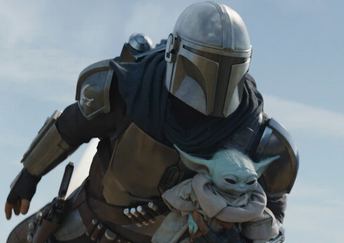“The Mandalorian” Season 2: Slow and Steady Wins the Race
December 21, 2020
*Major Spoiler Warning
![]() Despite the constant infighting within the “Star Wars” fandom, the majority of fans can agree that “The Mandalorian” is an exception to the rule—with the second season being a smash hit. “The Mandalorian”’s strong directing team and cast make the slowburn show worth watching.
Despite the constant infighting within the “Star Wars” fandom, the majority of fans can agree that “The Mandalorian” is an exception to the rule—with the second season being a smash hit. “The Mandalorian”’s strong directing team and cast make the slowburn show worth watching.
Due to the show’s slow-paced nature, the story is able to create a build-up that leads to powerful scenes such as moments between Mando and Grogu—formerly known as Baby Yoda—in Chapter 16. Throughout the series, viewers see the bond between the dynamic duo which ultimately comes to a head when Mando infiltrates enemy territory to rescue Grogu.
Their connection is further highlighted in a previous episode where Mando removes his helmet—which goes directly against his beliefs—in order to save Grogu. During the scene, even we as an audience feel uncomfortable seeing Mando make this sacrifice, but this action illustrates the lengths he would go for the child. However, that scene is contrasted with a moment from the finale where he, again, removes his helmet, but this time voluntarily. Mando shows his face to Grogu as a sign of vulnerability while they say their goodbyes. Unlike the last time, viewers now feel as though they’re allowed into this moment rather than forced to see an inevitable disaster. Though the scenes display a stark contrast, they are tied together by Mando’s fatherly compassion toward Grogu.
“The Mandalorian” also excels in writing earned pay-offs. This season showcased a multitude of cameos and fan-service moments, but each felt natural and still integral to the story while appealing to fans. For example, being surprised by a young Luke Skywalker battling across my screen was incredibly worth the wait given that the plot properly built up to the cameo rather than shoehorning it in.
While I believe that “The Mandalorian” is one of the few above average shows on streaming, this season still made some questionable choices. The show often fell prey to the trope of dumbing down characters for the sake of plot. For instance, the idea that Mando, a trained fighter and bounty hunter, would turn his back to Moff Gideon and naively fall for a trap seemed far-fetched. Not to mention, watching Mando attempt to break through a Force barrier three times in a row with nothing but his bare hands grew tiring.
Though I appreciate the show’s slowburn pacing, it still holds its downfalls. In the early episodes, Mando constantly journeyed from place to place in search of a MacGuffin, an object that is necessary to the plot but insignificant in itself, while accompanied by a one-off character. It felt as though Mando finally found his missing person or item, only to be sent packing to another planet in search of someone or something else. This plot device might be more tolerable with a wider cast—similar to the finale—because character dynamics and subplots allow for a flexible story. However, the story only revolves around Mando and Grogu, leading to father-son bonding being the single worthwhile character dynamic. Given that little dialogue occurs between the two, for obvious reasons, the audience isn’t given much to work with.
Even still, it’s clear that “The Mandalorian”’s eloquent storytelling and direction outweigh the few nitpicks I found. Every major plot point was matched by an even greater resolution that left fans satisfied and eager for the next season. I’m more than curious about the seeds planted for the upcoming plot and fully believe “The Mandalorian” is the best piece of “Star Wars”’s new era.









